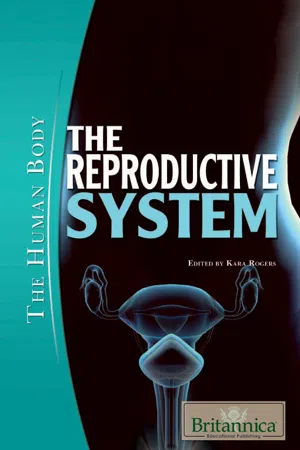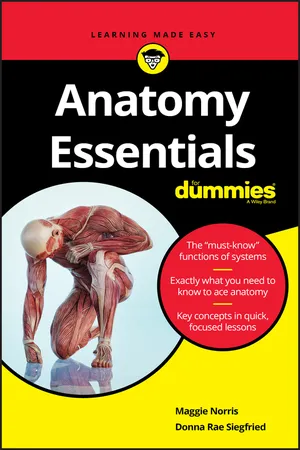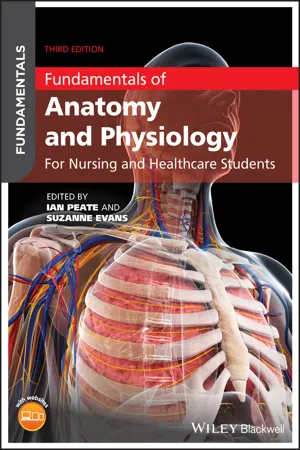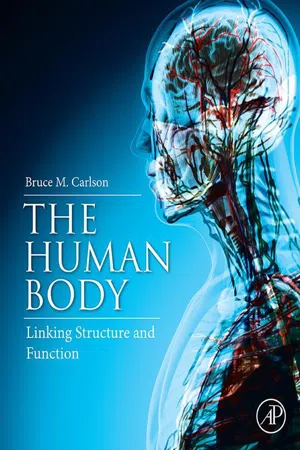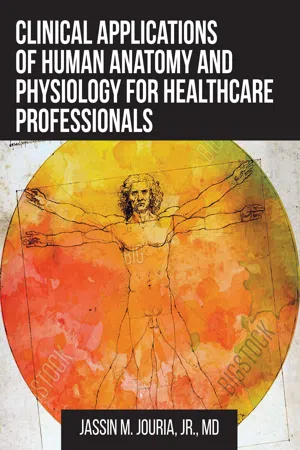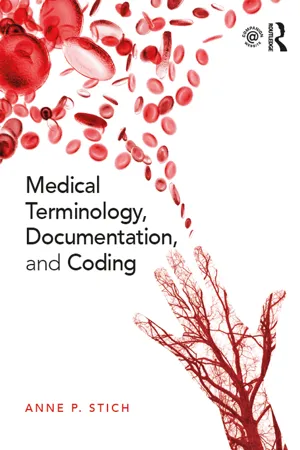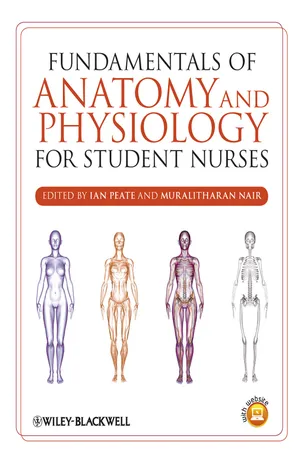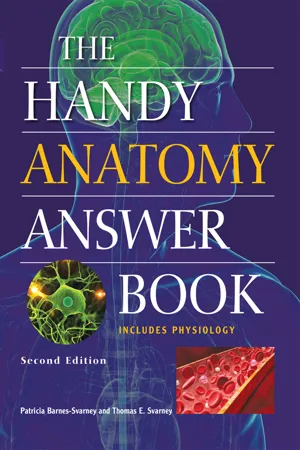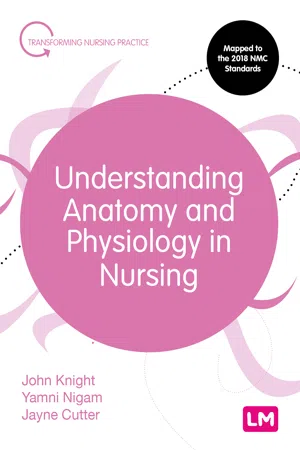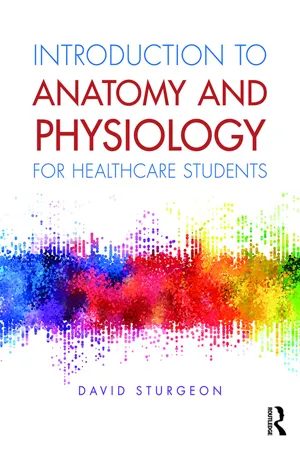Biological Sciences
Human Reproductive System
The human reproductive system is a collection of organs and glands that work together to produce offspring. In males, this system includes the testes, penis, and associated ducts and glands, while in females, it comprises the ovaries, fallopian tubes, uterus, and vagina. The system is responsible for the production of gametes (sperm and eggs) and the facilitation of fertilization and pregnancy.
Written by Perlego with AI-assistance
Related key terms
12 Key excerpts on "Human Reproductive System"
- eBook - ePub
- Britannica Educational Publishing, Kara Rogers(Authors)
- 2010(Publication Date)
- Britannica Educational Publishing(Publisher)
CHAPTER 1 ANATOMY OF THE HUMAN REPRODUCTIVE SYSTEMT he Human Reproductive System consists of a network of organs and signaling molecules that interact and communicate to give rise to the human ability to produce and bear live offspring. It is distinguished from all other organ systems of the human body by the fact that it is composed of two anatomically different organ plans, one for the female and one for the male. It is also a slow-developing system, with the reproductive organs obtaining full maturity at some point during adolescence, the transitional phase of growth and development between childhood and adulthood.Provided all organs are present, normally constructed, and functioning properly, the seven essential features of human reproduction are (1) liberation of an ovum, or egg, at a specific time in the reproductive cycle; (2) internal fertilization of the ovum by spermatozoa, or sperm cells; (3) transport of the fertilized ovum to the uterus, or womb; (4) implantation of the blastocyst, the early embryo developed from the fertilized ovum, in the wall of the uterus; (5) formation of a placenta and maintenance of the unborn child during the entire period of gestation; (6) birth of the child and expulsion of the placenta; and (7) suckling and care of the child, with an eventual return of the maternal organs to virtually their original state.For this biological process to be carried out, certain organs and structures are required in both the male and the female. The source of the ova (the female germ cells) is the female ovary; that of sperm (the male germ cells) is the testis. In females, the two ovaries are situated in the pelvic cavity. In males, the two testes are enveloped in a sac of skin, the scrotum, lying below and outside the abdomen. Besides producing the germ cells, or gametes, the ovaries and testes are the source of hormones that cause full development of secondary sexual characteristics and the proper functioning of the reproductive tracts. These tracts comprise the fallopian tubes, the uterus, the vagina, and associated structures in females and the penis, the sperm channels (epididymis, ductus deferens, and ejaculatory ducts), and other related structures and glands in males. The function of the fallopian tube is to convey an ovum, which is fertilized in the tube, to the uterus, where gestation (development before birth) takes place. The function of the male ducts is to convey sperm from the testis, to store them, and, when ejaculation occurs, to eject them with secretions from the male glands through the penis. - eBook - ePub
- Maggie A. Norris, Donna Rae Siegfried(Authors)
- 2019(Publication Date)
- For Dummies(Publisher)
Chapter 8Making Babies: The Reproductive System
IN THIS CHAPTERUnderstanding what the reproductive system doesGetting the gametes togetherLooking at the male and female reproductive organsResponding to the body’s changes during pregnancyLike all animals, humans have an instinctive knowledge of mating. However, only humans have a need to understand the processes of mating and reproduction. This chapter gives you information about the anatomy and physiology of reproduction. You’re on your own for info about dating and mating rituals.Surveying the Functions of the Reproductive System
The anatomy and physiology of the reproductive system is dedicated to supporting your role in continuing the human species (whether or not you choose to fulfill that role). Or to look at it another way, the reproductive system is dedicated to making sure your admirable characteristics are present in the next generation. Or to look at it from the “selfish-gene perspective,” your reproductive system is the means by which some genes replicate themselves and fight on in the never-ending battle for continuing existence.Following is an overview of what the reproductive system is responsible for:- Making gametes: The gametes are made within the organs of the female and male reproductive systems. Also called the sex cells, gametes are of two kinds: The ova (singular, ovum ) are the female gametes, and the sperm (singular, sperm ) are the male gametes. Specialized cells generate the gametes in a cell-division process called meiosis (see the “Crossing over with meiosis
- eBook - ePub
Fundamentals of Anatomy and Physiology
For Nursing and Healthcare Students
- Ian Peate, Suzanne Evans(Authors)
- 2020(Publication Date)
- Wiley-Blackwell(Publisher)
13 The Reproductive SystemsKaren MateTest Your Prior Knowledge
- Where does fertilisation occur?
- What is the inner layer of the uterus called?
- What is the role of the hormone testosterone?
- A woman is most fertile at what stage of the menstrual cycle?
- What is the function of the prostate gland and the testes?
Learning Outcomes
After reading this chapter you will be able to:- Describe the male and female reproductive organs.
- Understand the role and functions of the male reproductive system.
- Understand the role and functions of the female reproductive system.
- Provide an overview of the role and functions of the various hormones associated with the male and female reproductive systems.
- Outline the phases of the uterine cycle.
Visit the student companion website at www.wileyfundamentalseries.com/anatomy where you can test yourself using flashcards, multiple-choice questions and more. Instructor companion site at www.wiley.com/go/instructor/anatomy where instructors will find valuable materials such as PowerPoint slides and image bank designed to enhance your teaching.Body Map
Introduction
Reproduction is one of the most important and essential attributes of living organisms; all living organisms reproduce to create new individuals of their own kind, thereby giving rise to the next generation. Although not necessary for survival of the individual, reproduction is essential for survival of the species. Human reproduction is sexual; the male gamete (sperm) and female gamete (ovum) combine at fertilisation resulting in a new and unique combination of parental genes. The structure and function of the reproductive systems is a major point of difference between men and women.The gametes are produced by gonads; testes produce sperm in the male, and the ovaries produce ova in the female. The gonads also produce hormones required for the development, upkeep and performance of the reproductive organs and other sexual characteristics. Fertilisation occurs inside the body of the female to form a zygote, which goes on to develop into an embryo and then a fetus. The female reproductive organs take on the responsibility for nurturing the developing fetus until birth. After birth, the mother continues to provide nutritional support for the child through lactation and breastfeeding. - eBook - ePub
The Human Body
Linking Structure and Function
- Bruce M. Carlson, Bruce M. Carlson(Authors)
- 2018(Publication Date)
- Academic Press(Publisher)
Chapter 14The Reproductive System
Abstract
Under precise hormonal control, both male and female reproductive systems are designed first to produce viable gametes, and then bring them together, and finally to nourish the resulting embryo within the mother’s uterus. Sperm production occurs in the testis, and functional maturation takes place in the epididymis. During ejaculation, spermatozoa are rapidly transported from the epididymis through the ductus deferens, at the end of which the sperm are joined by secretions of the seminal vesicle and prostate gland. Within the female reproductive tract, spermatozoa must make their way from the vagina through the cervix and into a uterine tube, where they might encounter an egg. Within the ovary, oocytes undergo meiosis and acquire a cellular covering to produce follicles. The follicular cells both receive and produce important reproductive hormones. Ovulation occurs at a precise time in the menstrual cycle, when the female reproductive tissues are prepared to facilitate sperm transport and fertilization and the transport and implantation of the embryo, should fertilization occur. The lining of the uterus is well adapted to support growth of the embryo. After parturition, the baby is supported by milk produced by the mother’s mammary glands. Milk production is under both hormonal and neural control.Keywords
Testis; spermatogenesis; spermatozoon; sperm transport; epididymis; ductus deferens; physiology of erection and ejaculation; prostate; seminal vesicle; ovary; uterine tube; uterus; vagina; oogenesis; ovum; ovulation; egg transport; menstrual cycle; fertilization; embryo transport and implantation; pregnancy; parturition; placenta; mammary gland; lactationThe reproductive system exists for the sole purpose of perpetuating the species. For purely genetic reasons, hundreds of million years ago, animals abandoned fission as a strategy for reproduction in favor of sexual reproduction. This change in strategy necessitated the evolution of separate sexes. The main function of females is to produce eggs; the main function of males is to produce sperm, which fertilize the eggs. Beyond these basic functions, animals have evolved an amazing variety of strategies for not only producing gametes, but bringing them together. - Jassin M. Jouria(Author)
- 2018(Publication Date)
- BrownWalker Press(Publisher)
Understanding the components of both the male and female reproductive system and how reproduction works is important for students entering the healthcare field. As an EMT or a paramedic, you may be called to a scene where a pregnant woman is undergoing premature labor or has been injured in an auto accident, which can endanger not only the life of the mother, but the fetus. As a nurse or physician, you may be called to the emergency room to take care of a patient whose external genitalia have been damaged due to some type of traumatic injury. The basics of reproductive organs and their functions are explored in this chapter.Reproduction relies on fertilization of the male sperm (spermatozoa) and a female ova (egg). As with other body organ and systems students have studied throughout this textbook, numerous body systems provide support to others. The reproductive system relies on the endocrine system for optimal function, as hormones affect not only processes involved in reproduction, but other body functions.Unlike most other body systems, the Human Reproductive System doesn’t develop until a young male or female reaches puberty. Puberty is basically defined as a process of physical alterations or changes that occur in the body during transition from childhood into adolescence. It’s at this point in time where sexual reproduction is possible.Figure 15-1 Primary function of reproduction - life.Despite the differences found between male and female reproductive physiology, both are designed for one thing: reproduction. The importance of the gross anatomy, physiology, and the relationships between not only the reproductive organs but the hormones that supply them – and how they work together – is the focus of this chapter.- ■ Male Reproductive Organs: Gross Anatomy
Male reproductive system anatomy focuses on the genitalia. The primary components of male genitalia include the scrotum, inside which reside the testes. The penis is sometimes defined as a “tail” of sorts, which suspends from the perineum and is the primary structure of the male external genitalia.- eBook - ePub
- Anne P. Stich(Author)
- 2018(Publication Date)
- Routledge(Publisher)
does populate the species – building societies, communities, and cultures over thousands of years. The mystic of the anatomy of sexual reproduction continues even today, with each culture having specific terms and slang to describe the act of procreation.Figure 15.2 Reproductive health has always had many ethical questions swirling nearby. Here are a few:• Religion: sex should only take place for the act of procreation, not for enjoyment.• Responsibility: since the woman bears the child she should be responsible for birth control.• Timing: when is the product of conception alive? Does the fetus have rights?• Language: should advertisers use words such as ‘erectile dysfunction’ during family viewing time? How and who educates young people on sexual matters?• Health: sexually transmitted diseases should be private, not an issue for Public Health?• Genetics: if we can fix the gene for Down syndrome or other genetic diseases, should we? What do we do with the errors in genetic manipulation?Medical care and documentation provides the starting place and perhaps the ending place for some of these questions. These are real and sometime volatile topics merging with politics, private beliefs, and public health on a regular basis. As providers and patients, it is important to listen and provide quality education and care to all people equally to avoid the angst of the ethics.THE MALE REPRODUCTIVE SYSTEMThe male reproductive system is designed to produce, transport, and discharge the male gamete, the sperm in the process of reproduction (Figure 15.3 ). There are three hormones effecting this process directly and a number of word roots to describe the anatomy.Figure 15.3 The external genitalia of men is more noticeable and there is a dictionary’s worth of slang terms for the anatomy and activity of these body parts.• Phall /o > the penis > copulation (kop-U-lay-shun) organ for men, it changes in size when stimulated to allow the ejaculation of the semen. The base of the penis is at the abdomin - Ian Peate, Muralitharan Nair(Authors)
- 2011(Publication Date)
- Wiley-Blackwell(Publisher)
Reproduction is one of the most important and essential attributes of living organisms. Every sort of living organism multiplies to form new individuals of its own kind through reproduction. One generation of living organisms gives rise to the next generation as they reproduce. Reproduction is not critical to the life of any individual however; it is a function essential for the life of the species. In humans reproduction is sexual; this means that children are produced as a consequence of male and female mating (Stanfield 2011).Fertilisation occurs inside the body of the female; the human sexual organs are dedicated to this. The reproductive systems work together to maintain homeostasis with other body systems.Sexual reproduction usually concludes with the production of children for the continued existence of the species, as well as passing on hereditary characteristics from one generation to the next. It is the male and female reproductive systems that contribute to the events that lead to fertilisation. When this has occurred it is the female organs that take on the responsibility for developing the human and giving birth. The testes and ovaries produce sperm and ova as well as the hormones required for the development, upkeep and performance of the organs of reproduction and other organs and tissues.This chapter provides an overview of the structure and functions of both male and female reproductive systems. The anatomical systems of the male and female, unlike any of the other anatomical systems in the body, differ in males and females (Tucker 2008).The male and female reproductive systems consist of the reproductive organs. In the male the organs are the testes, accessory ducts, accessory glands and the penis. In the female the organs are the uterus, uterine tubes, ovaries, vagina and the vulva.The male reproductive systemThe male reproductive system is more obvious than the female reproductive system as most of the organs are outside of the body – but there are both internal and external structures. Male reproductive organs, working in tandem with other body systems, for example, the neuroendocrine system, make the hormones that are important in biological development and sexual behaviour, performance and actions. These organs also include and are central to the function of the urinary system. The male reproductive system is shown in Figure 15.1- eBook - ePub
- Patricia Barnes-Svarney, Thomas E. Svarney(Authors)
- 2016(Publication Date)
- Visible Ink Press(Publisher)
INTRODUCTION What are the organs of the reproductive system and their general function?The overall function of the reproductive system is to produce new offspring. Thus, the continuity of the human species is guaranteed through reproduction. The major organs of the reproductive system are the gonads, various ducts, accessory sex glands, and supporting structures. The gonads produce gametes and secrete hormones. The various ducts store and transport the gametes. The accessory sex glands produce substances that protect the gametes. The supporting structures assist the delivery and joining of gametes.Are the male and female reproductive systems identical?Unlike every other organ system in the human body, the male and female reproductive systems are not identical. The specialized organs of the male and female reproductive systems are different. However, it is essential for both the male and female reproductive systems to be involved in order for reproduction to occur.Which branches of medicine specialize in the female and male reproductive systems?Gynecology (from the Greek gune, meaning “woman”) is the branch of medicine that specializes in the diagnosis and treatment of conditions of the female reproductive system. Urology is the branch of medicine that specializes in the treatment of medical conditions of the male reproductive system.The female reproductive systemMALE REPRODUCTIVE SYSTEM What are the male reproductive organs and structures?The male reproductive organs and structures are the testes, a duct system that includes the epididymis and the vas deferens; the accessory glands, including the seminal vesicles and prostate gland; and the penis.What are the testes and where are they located?The testes are the male gonads that produce the male reproductive cells called sperm. The testes hang in a pouch called the scrotum (from the Latin scrautum, - Available until 29 Sep |Learn more
- John Knight, Yamni Nigam, Jayne Cutter(Authors)
- 2020(Publication Date)
- Learning Matters(Publisher)
Chapter 12 The reproductive systemsChapter aims
After reading this chapter, you will be able to:- describe the major anatomical structures of the male and female reproductive tracts;
- explain the processes of spermatogenesis and oogenesis;
- describe the stages of the menstrual cycle;
- highlight the role of the major sex hormones on human physiology;
- provide an overview of some of the common pathologies that affect the reproductive systems.
Introduction
Case study: Ahmed – prostate cancer
Ahmed visited his GP a month ago on the insistence of his wife, who had been worried about his constant visits to the toilet. Ahmed has noticed for the last couple of years that it has become increasingly difficult to urinate and has noticed a weakening in his urine stream which has progressively reduced to a trickle. More worryingly, for the last few weeks passing urine has become painful with a burning sensation, and Ahmed is having to strain to produce a urine stream.During a digital rectal exam, Ahmed’s GP noted a hard, palpable, nodular mass and arranged for a blood sample to be collected which revealed elevated levels of prostate-specific antigen (PSA). Ahmed was referred to the urology clinic and, following an endorectal ultrasound scan and 12-core needle biopsy, received a diagnosis of stage II prostate cancer for which he is currently receiving treatment.Introduction
As well as facilitating the process of human reproduction, the male and female reproductive tracts produce a variety of sex hormones including testosterone, oestrogen and progesterone, which play diverse roles in human physiology. This chapter will begin by exploring the anatomy and physiology of the male reproductive tract, including the role of the testes in spermatogenesis (production of sperm) and testosterone synthesis. - Thomas P. Colville, Joanna M. Bassert(Authors)
- 2015(Publication Date)
- Mosby(Publisher)
Clinical significance
Veterinary clients generally fall into one of two groups when it comes to reproduction: those who want their animals to reproduce, and those who want to prevent their animals from reproducing. It is important for us to understand the male and female reproductive organs and structures so we can be of help to both groups.testtestIntroduction
The reproductive system’s sole purpose is to produce offspring. It affects other parts of the body, including behavior, but all those influences are focused on promoting breeding and pregnancy. For the reproductive system to carry out its mission, the physical and behavioral characteristics of a female animal and a male animal must be prepared and coordinated. So, the reproductive system really includes the reproductive structures and processes of both the male and female animals.For convenience, we divide things up into the male reproductive system and female reproductive system.The Male Reproductive System• Produces male sex hormones (principally testosterone) • Produces and stores the male reproductive cells (spermatozoa) • Delivers them to the female reproductive tract at the time of breedingThe Female Reproductive System• Produces the female sex hormones (principally estrogen) • Produces the female reproductive cells (ova) • Receives the spermatozoa-containing semen at the time of breeding • Produces pregnancy-promoting hormones (principally progesterone) • Houses and nourishes the developing offspring after fertilization of the ovum has taken placeAt the end of the gestation (pregnancy) period, contractions of the uterus and abdominal muscles push the fully developed offspring out into the world. The birth process is called parturition.Materials needed
Preserved specimens: intact male and intact female- eBook - ePub
Subfertility
Recent Advances in Management and Prevention
- Rehana Rehman, Aisha Sheikh(Authors)
- 2020(Publication Date)
- Elsevier(Publisher)
Interplay of female endocrine and reproductive systems- Conclusions
- References
Physiology of the male reproductive system
Introduction
The male reproductive physiology involves external structures (scrotum and penis) and internal structures (testis, epididymis, vas deferens, and prostate). These are well vascularized and supported by several other glands. The primary male androgen hormone is testosterone produced by Leydig cells in the testis, but other hormones like inhibin and Mullerian-inhibiting substance produced by Sertoli cells also contribute to the male reproductive physiology. Follicular-stimulating hormone (FSH) and luteinizing hormone (LH), produced from the anterior pituitary, under control of the hypothalamic hormone, gonadotropin- releasing hormone (GnRH) are involved in the regulation of the male reproductive physiology and together these hormones form the hypothalamic–pituitary–gonadal axis.Functions of male reproductive organs
The male reproductive system, through the hypothalamic–pituitary–gonadal axis, is responsible for male sexual development/maturity, including the formation of secondary sex characteristics for males. In addition, it is necessary for sperm production (spermatogenesis) and lifelong maintenance of male sexuality. The male reproductive system also assists in the transport of generated sperms into the female reproductive system for fertilization. Sperm production and transport occur in the testis, alongside the production of the male androgen, testosterone. Thus, the testes have exocrine and endocrine functions simultaneously.1Internal male reproductive organs
- a. Testes: Paired male sex organs located in the scrotum, normally 4–5 cm in size, these are the sites for spermatogenesis and male sex hormone production (Fig. 2.1 ).Fig. 2.1 Functional anatomy and sperm transport structure in the testis.Each testis consists of 300–400 lobules, consisting of seminiferous tubules. Spermatogenesis occurs within the lining of the lumen of these tubules. Inside the seminiferous tubules are two main types of cells, Sertoli/supporting cells and germ cells1
- David Sturgeon(Author)
- 2018(Publication Date)
- Routledge(Publisher)
14 Reproductive systemContents
- Reproduction
- Alleles
- Genetic diversity
- Male reproductive system
- Scrotum
- Testes
- Testosterone
- Epididymis
- Sperm transport
- Seminal vesicles, prostate and bulbourethral glands
- Prostate enlargement
- Urethra, penis and foreskin
- Erection
- Semen
- Ejaculation
- Vasectomy
- Female reproductive system
- Vagina
- Uterus
- Uterine tissue
- Fallopian tubes and fimbriae
- Ovaries
- Oogenesis
- Menstrual cycle and oestrogen
- Ovulation
- Progesterone
- Fertilisation
- Gender determination
- Twins and singletons
- Implantation
- Placenta
- Chapter 14: Test yourself
Reproduction
Figure 14.1 Meiosis and mitosis pre- and post-conception.In humans, reproduction refers to the ability to conceive and produce the next generation of offspring. This usually occurs as a result of sexual intercourse between a man and a woman, although artificial insemination (directly inserting sperm into the woman’s womb) and in vitro fertilisation (fertilising the egg in a laboratory before implanting it into the womb) also enables this process to take place without the need for actual sex. The most important attribute or quality of reproduction is the combination and mixing of genetic material from both biological parents to ensure that the child is as genetically diverse as possible. In Chapter 2 , we saw that human characteristics are transferred from generation to generation by genes located on 23 pairs of chromosomes (46 in total). In order to ensure that the child receives a mix of genetic material from each parent, male and female sex cells (gametes) have 23 unpaired chromosomes. These cells are known as haploid cells and are created during meiotic (or reductive) division of the cell nucleus. The 23 chromosomes in each gamete is not a random selection from the 46 chromosomes of the parent. It consists of one (of each pair) of the 22 autosomes, plus either an X or Y chromosome. X and Y chromosomes are called sex chromosomes since they determine gender (see below). Cells that are produced via mitosis are known as diploid cells and have 46 chromosomes (or 23 pairs). The only haploid cells produced by the human body are male and female gametes: spermatozoa and ova (see below). At fertilisation, they combine to create a new (diploid) cell with a full complement of chromosomes (Figure 14.1
Index pages curate the most relevant extracts from our library of academic textbooks. They’ve been created using an in-house natural language model (NLM), each adding context and meaning to key research topics.
